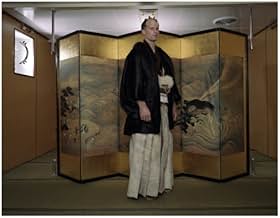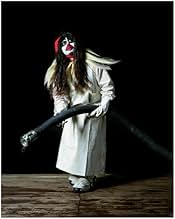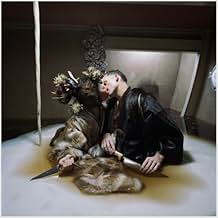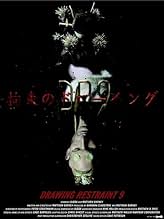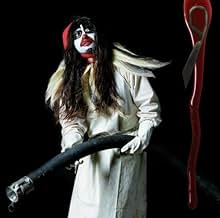VALUTAZIONE IMDb
6,5/10
1589
LA TUA VALUTAZIONE
Aggiungi una trama nella tua linguaThe film concerns the theme of self-imposed limitation and continues Matthew Barney's interest in religious rite, this time focusing on Shinto.The film concerns the theme of self-imposed limitation and continues Matthew Barney's interest in religious rite, this time focusing on Shinto.The film concerns the theme of self-imposed limitation and continues Matthew Barney's interest in religious rite, this time focusing on Shinto.
- Regia
- Sceneggiatura
- Star
- Premi
- 1 candidatura in totale
Recensioni in evidenza
It you are Japanese or know something about Japanese mythology and/or whaling culture in japan, then this movie will mean a lot more to you than others.
I know most people who watch this movie will come out of the theater ferociously hating Matthew Barney and be turned off of modern art, but for me, this movie was grounded in ancient Japanese traditions. And to have witnessed it, even if it is bastardized from it's Japanese roots, is a fortunate event.
I'll attempt to write the plot as I saw it.
Barney and Bjork were invited onto the whaling vessel as guests. They begin their journey by transforming into sea spirits through several elaborate and beautiful (however long and confusing) ceremonies and rites of passages . This all happens while the whaling crew perform their duties on the symbolic whale. In the end the journey takes a gruesome turn and the transformation is complete.
This is by no means an easy movie to sit through, be forewarned. However, I believe the value is in your furthered exploration into the subject of Japanese culture, ritual and mythology.
Be sure to check out the exhibit at your local museum if it comes to your town. It is absolutely amazing to see.
I know most people who watch this movie will come out of the theater ferociously hating Matthew Barney and be turned off of modern art, but for me, this movie was grounded in ancient Japanese traditions. And to have witnessed it, even if it is bastardized from it's Japanese roots, is a fortunate event.
I'll attempt to write the plot as I saw it.
Barney and Bjork were invited onto the whaling vessel as guests. They begin their journey by transforming into sea spirits through several elaborate and beautiful (however long and confusing) ceremonies and rites of passages . This all happens while the whaling crew perform their duties on the symbolic whale. In the end the journey takes a gruesome turn and the transformation is complete.
This is by no means an easy movie to sit through, be forewarned. However, I believe the value is in your furthered exploration into the subject of Japanese culture, ritual and mythology.
Be sure to check out the exhibit at your local museum if it comes to your town. It is absolutely amazing to see.
There's no dialogue for a while, and then there's some Japanese dialogue, and all the while, I didn't really know what was going on. I was lost at pretty much all times, but that was to be expected. This had "avant-garde" written all over it, and for being an art piece, I guess it's sporadically interesting. It probably achieves what it sets out to do, but whatever that is feels unclear to me. If you want to dive in, there's probably a lot to chew on, but as to whether it would taste any good, who knows. Probably not. But it's challenging. That's more of an observation rather than something that makes it bad or good. And there's some music here composed by Bjork, though she didn't do all the music it seems. I don't know.
That's my take away. I don't know.
That's my take away. I don't know.
Some of the themes that emerged for me: Minimizing use of natural resources in order to maximize the full capacity of human intelligence.
The role of ritual as a focuser of intent that enables utter, literal transformation.
Profound understanding of other forms of life via literal experience of what they have lived (in this case, using that species' human interaction as an entry point for understanding).
Civilized human society's penchant for consuming nature to benefit materially while suppressing our (well documented) ability to shift shape as a means of enriching our intelligence immeasurably.
I noticed how my mind didn't even question the industrialized hierarchy presented in the film, the ritual of common human toil or even the pageantry that has traditionally accompanied industrial "progress." But I had to struggle with the ritual that became the vehicle of transformation for the two main characters.
What seemed like an unnatural act turned out to be only the human part of what is encountered by the species our hero and heroine sought to be. Their yearning to BE and experience that species seemed very natural.
The role of ritual as a focuser of intent that enables utter, literal transformation.
Profound understanding of other forms of life via literal experience of what they have lived (in this case, using that species' human interaction as an entry point for understanding).
Civilized human society's penchant for consuming nature to benefit materially while suppressing our (well documented) ability to shift shape as a means of enriching our intelligence immeasurably.
I noticed how my mind didn't even question the industrialized hierarchy presented in the film, the ritual of common human toil or even the pageantry that has traditionally accompanied industrial "progress." But I had to struggle with the ritual that became the vehicle of transformation for the two main characters.
What seemed like an unnatural act turned out to be only the human part of what is encountered by the species our hero and heroine sought to be. Their yearning to BE and experience that species seemed very natural.
Drawing Restraint 9 (5 stars)
Director Matthew Barney Writer Matthew Barney Stars Matthew Barney, Björk Certificate tbc Running time 135 minutes Country USA / Japan Year 2005
Matthew Barney is a visual artist. Think 'film' as in the sort of media that might attract the attention of the Turner Prize or, its American equivalent (with an international remit), the Hugo Boss award. The most recent Hugo Boss award was won by a Brit, Tacita Dean (who has also been shortlisted for the Turner). Barney won it back in 1996 and has garnered a string of prizes since. So you could say that, in his field, he's comfortably at the top of the heap.
I mention all this because you may come to a review of his film with the question, "But will I like it?" And while that question is still open, it is probably rather better than, "Is it any good?"
Although Barney has his critics, even in the art world, to suggest his stuff is rubbish is maybe a bit like saying Meryl Streep can't act: her finished work may vary in quality but it's the product of someone at the top of their profession. But even if Drawing Restraint 9 is great art of which this reviewer is unqualified to say it is reasonable to wonder whether going to the cinema should entail the attitude of mind that going to see a Tate Modern multi-media application might demand. Surely a film-goer has every right to judge a fill as a movie rather than an art exhibit?
Drawing Restraint 9 demands more or perhaps a rather different type of application to the type of movie commonly at art house cinemas. Yet I recall the delightful shock of seeing Bunuel's Un Chien Andalou that unapologetically surrealist outburst that resulted from his friendship with Salvador Dali. Or Andy Warhol's Screen Tests, that reveal astonishing depth in the personalities instructed not to move or blink for four minutes. More recently Béla Tarr's masterpiece, The Man From London, where the scenery carries a force as powerful as the plot or characters. These people dared to use moving pictures in a different way, and cinema is (in my opinion) better for them.
Matthew Barney has little or no interest that I can deduce in conventional cinematic form. When it comes to film, it is as if he started with a blank page, or another medium upon which to bend like sculpture and ideas. Fans of his earlier Cremaster cycle of films will recognise a certain organic development in his films: the plots and persons seems to grow in a way that mimics the growth of crystals, or of speeded up plant growth, all redolent with arcane or sexual symbolism.
Drawing Restraint 9 seems to me a more rounded and mature work than his Cremaster opus. It is more tightly structured and coherent. The viewer can piece together the threads of stories by patient observation. The work of a Japanese whaling ship and various issues surrounding its trade, and the Shinto marriage ceremony on board. During an intense lightning storm the tea ceremony / marriage ceremony takes on disturbing dimensions that set our mind and senses racing.
Barney's (real life) partner, Bjȍrk also combines many new ideas in creating the music. The main suite is written for the sho, one of Japan's most ancient instruments. She worked with Noh theatre scholars to develop musical settings for a poem to produce an authentic, haunting sound.
Drawing Restraint 9 is no more an easy cinematic experience than a Rodin is a catchy picture postcard. But it rewards serious attention and its lyrical and elegiac qualities make the journey an interesting one. The strange visual experiences will leave an impression even on viewers that don't delve beyond the surface. Those that do, will find Barney has drawn his cinematic sculpture on sound ideas and symbols of substance.
Director Matthew Barney Writer Matthew Barney Stars Matthew Barney, Björk Certificate tbc Running time 135 minutes Country USA / Japan Year 2005
Matthew Barney is a visual artist. Think 'film' as in the sort of media that might attract the attention of the Turner Prize or, its American equivalent (with an international remit), the Hugo Boss award. The most recent Hugo Boss award was won by a Brit, Tacita Dean (who has also been shortlisted for the Turner). Barney won it back in 1996 and has garnered a string of prizes since. So you could say that, in his field, he's comfortably at the top of the heap.
I mention all this because you may come to a review of his film with the question, "But will I like it?" And while that question is still open, it is probably rather better than, "Is it any good?"
Although Barney has his critics, even in the art world, to suggest his stuff is rubbish is maybe a bit like saying Meryl Streep can't act: her finished work may vary in quality but it's the product of someone at the top of their profession. But even if Drawing Restraint 9 is great art of which this reviewer is unqualified to say it is reasonable to wonder whether going to the cinema should entail the attitude of mind that going to see a Tate Modern multi-media application might demand. Surely a film-goer has every right to judge a fill as a movie rather than an art exhibit?
Drawing Restraint 9 demands more or perhaps a rather different type of application to the type of movie commonly at art house cinemas. Yet I recall the delightful shock of seeing Bunuel's Un Chien Andalou that unapologetically surrealist outburst that resulted from his friendship with Salvador Dali. Or Andy Warhol's Screen Tests, that reveal astonishing depth in the personalities instructed not to move or blink for four minutes. More recently Béla Tarr's masterpiece, The Man From London, where the scenery carries a force as powerful as the plot or characters. These people dared to use moving pictures in a different way, and cinema is (in my opinion) better for them.
Matthew Barney has little or no interest that I can deduce in conventional cinematic form. When it comes to film, it is as if he started with a blank page, or another medium upon which to bend like sculpture and ideas. Fans of his earlier Cremaster cycle of films will recognise a certain organic development in his films: the plots and persons seems to grow in a way that mimics the growth of crystals, or of speeded up plant growth, all redolent with arcane or sexual symbolism.
Drawing Restraint 9 seems to me a more rounded and mature work than his Cremaster opus. It is more tightly structured and coherent. The viewer can piece together the threads of stories by patient observation. The work of a Japanese whaling ship and various issues surrounding its trade, and the Shinto marriage ceremony on board. During an intense lightning storm the tea ceremony / marriage ceremony takes on disturbing dimensions that set our mind and senses racing.
Barney's (real life) partner, Bjȍrk also combines many new ideas in creating the music. The main suite is written for the sho, one of Japan's most ancient instruments. She worked with Noh theatre scholars to develop musical settings for a poem to produce an authentic, haunting sound.
Drawing Restraint 9 is no more an easy cinematic experience than a Rodin is a catchy picture postcard. But it rewards serious attention and its lyrical and elegiac qualities make the journey an interesting one. The strange visual experiences will leave an impression even on viewers that don't delve beyond the surface. Those that do, will find Barney has drawn his cinematic sculpture on sound ideas and symbols of substance.
This experimental film is utterly gorgeous. Barney's film's are as ambitious as any Hollywood blockbuster. The visuals are stunning and the soundtrack by Bjork is the best music to date for one of the artist's projects. If this film comes to your town, I highly recommend checking it out. The narrative structure is somewhat unusual and the film contains almost no dialogue. I found the experience reminiscent of my first time seeing Kubrick's "2001: A Space Odyssey". If you're looking for action, this may not be your cup of tea (ha ha). The Japanese locations, the costumes, music, sets, cinematography & special effects create a seamless and highly polished package.
Lo sapevi?
- Colonne sonoreGratitude
Written by Björk and Matthew Barney
Vocal by Will Oldham
Harp played by Zeena Parkins
Celeste played by Jónas Sen
Keyboard played by Nico Muhly
Arranging & editing by Björk
Programming by Björk and Valgeir Sigurðsson
Produced by Björk
I più visti
Accedi per valutare e creare un elenco di titoli salvati per ottenere consigli personalizzati
- How long is Drawing Restraint 9?Powered by Alexa
Dettagli
Botteghino
- Lordo Stati Uniti e Canada
- 234.743 USD
- Fine settimana di apertura Stati Uniti e Canada
- 18.011 USD
- 2 apr 2006
- Lordo in tutto il mondo
- 267.275 USD
- Tempo di esecuzione
- 2h 15min(135 min)
- Colore
- Mix di suoni
- Proporzioni
- 1.85 : 1
Contribuisci a questa pagina
Suggerisci una modifica o aggiungi i contenuti mancanti



